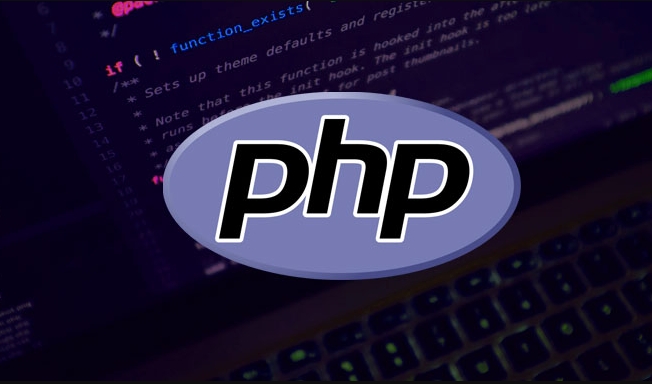How to properly document a PHP function with PHPDoc?
Jul 03, 2025 am 10:26 AMThe key to writing a good PHPDoc is to have clear structure and accurate information. First, we must follow the basic structural specifications, use /*/ package annotations, and use @param, @return, @throws and other tags reasonably; secondly, we must pay attention to the description details of parameters and return values, clearly explain the meaning and format, rather than just writing the type; then we can choose @var, @deprecated, @see, @link, @todo and other tags that enhance readability to improve document expression; finally, keep the description concise and not redundant, and use the array{} syntax of PHP 8.1 to explicitly return the structure, making PHPDoc more practical.

When writing PHPDoc, many people just add a comment, but it is not very useful. A truly useful PHPDoc is a structured comment that allows people to quickly understand the functions, parameters and return values, and can also be recognized by the IDE to improve code readability and maintenance.

The following points are the things you should pay attention to when writing PHPDoc.

Basic structure must be standardized
The basic format of PHPDoc is wrapped in /** */ , each line begins with an asterisk. The most common tags include:
-
@param: Explain the type and meaning of each parameter -
@return: Explain the return value type and meaning -
@throws: If an exception is thrown, it must be noted
For example, this example:

/**
* Calculate the difference in the number of days between two dates*
* @param string $startDate Start date, format Ymd
* @param string $endDate End date, format Ymd
* @return int Return the number of days difference* @throws Exception throws an exception if the date format is incorrect*/
function calculateDateDifference($startDate, $endDate) {
// Function logic}A few points to note:
- Parameter alignment looks good but not necessary. The key is accurate information
- Try to write specific types, such as
string[]is clearer thanarray - The description should be concise, without repeating the meaning of the variable name, but supplementing the purpose
Enhance readability with the right label
In addition to basic tags, some tags can make your documentation clearer:
-
@var: used for variable annotation, especially array element types, etc. -
@deprecated: marking a function is deprecated, which alternative is recommended -
@seeor@link: Quoting other methods or external documents -
@todo: Explain what may be improved in the future
For example:
/**
* Get basic information about users*
* @deprecated Please use getUserProfile() instead of * @see getUserProfile()
* @return array{ id: int, name: string } User information*/
function getUserInfo() {
// ...
}Although these tags are not necessary, they are very useful in teamwork or open source projects and can reduce communication costs.
Don't ignore the details of return values ??and parameters
Many PHPDoc comments only write parameter names and types, but do not specify the actual meaning. for example:
@param string $format date format
It's better to write it as:
@param string $format output format, supports 'Ymd' and 'd/m/Y'
In this way, when others call, they will know which formats you support, rather than guessing.
The same is true for the return value. If the returned array or object is returned, the structure can be described using array{} syntax supported by PHP 8.1:
@return array{title: string, author: string, published: bool} This way of writing is much better than array .
Basically that's it. PHPDoc does not need to be too complicated, but it needs to write down key information clearly, such as how to use parameters, what to return, and whether there are side effects. Writing well will not only make it easier for others to understand your code, but the IDE can also automatically complete and prompt errors. This is its real value.
The above is the detailed content of How to properly document a PHP function with PHPDoc?. For more information, please follow other related articles on the PHP Chinese website!

Hot AI Tools

Undress AI Tool
Undress images for free

Undresser.AI Undress
AI-powered app for creating realistic nude photos

AI Clothes Remover
Online AI tool for removing clothes from photos.

Clothoff.io
AI clothes remover

Video Face Swap
Swap faces in any video effortlessly with our completely free AI face swap tool!

Hot Article

Hot Tools

Notepad++7.3.1
Easy-to-use and free code editor

SublimeText3 Chinese version
Chinese version, very easy to use

Zend Studio 13.0.1
Powerful PHP integrated development environment

Dreamweaver CS6
Visual web development tools

SublimeText3 Mac version
God-level code editing software (SublimeText3)
 PHP Variable Scope Explained
Jul 17, 2025 am 04:16 AM
PHP Variable Scope Explained
Jul 17, 2025 am 04:16 AM
Common problems and solutions for PHP variable scope include: 1. The global variable cannot be accessed within the function, and it needs to be passed in using the global keyword or parameter; 2. The static variable is declared with static, and it is only initialized once and the value is maintained between multiple calls; 3. Hyperglobal variables such as $_GET and $_POST can be used directly in any scope, but you need to pay attention to safe filtering; 4. Anonymous functions need to introduce parent scope variables through the use keyword, and when modifying external variables, you need to pass a reference. Mastering these rules can help avoid errors and improve code stability.
 How to handle File Uploads securely in PHP?
Jul 08, 2025 am 02:37 AM
How to handle File Uploads securely in PHP?
Jul 08, 2025 am 02:37 AM
To safely handle PHP file uploads, you need to verify the source and type, control the file name and path, set server restrictions, and process media files twice. 1. Verify the upload source to prevent CSRF through token and detect the real MIME type through finfo_file using whitelist control; 2. Rename the file to a random string and determine the extension to store it in a non-Web directory according to the detection type; 3. PHP configuration limits the upload size and temporary directory Nginx/Apache prohibits access to the upload directory; 4. The GD library resaves the pictures to clear potential malicious data.
 Commenting Out Code in PHP
Jul 18, 2025 am 04:57 AM
Commenting Out Code in PHP
Jul 18, 2025 am 04:57 AM
There are three common methods for PHP comment code: 1. Use // or # to block one line of code, and it is recommended to use //; 2. Use /.../ to wrap code blocks with multiple lines, which cannot be nested but can be crossed; 3. Combination skills comments such as using /if(){}/ to control logic blocks, or to improve efficiency with editor shortcut keys, you should pay attention to closing symbols and avoid nesting when using them.
 How Do Generators Work in PHP?
Jul 11, 2025 am 03:12 AM
How Do Generators Work in PHP?
Jul 11, 2025 am 03:12 AM
AgeneratorinPHPisamemory-efficientwaytoiterateoverlargedatasetsbyyieldingvaluesoneatatimeinsteadofreturningthemallatonce.1.Generatorsusetheyieldkeywordtoproducevaluesondemand,reducingmemoryusage.2.Theyareusefulforhandlingbigloops,readinglargefiles,or
 Tips for Writing PHP Comments
Jul 18, 2025 am 04:51 AM
Tips for Writing PHP Comments
Jul 18, 2025 am 04:51 AM
The key to writing PHP comments is to clarify the purpose and specifications. Comments should explain "why" rather than "what was done", avoiding redundancy or too simplicity. 1. Use a unified format, such as docblock (/*/) for class and method descriptions to improve readability and tool compatibility; 2. Emphasize the reasons behind the logic, such as why JS jumps need to be output manually; 3. Add an overview description before complex code, describe the process in steps, and help understand the overall idea; 4. Use TODO and FIXME rationally to mark to-do items and problems to facilitate subsequent tracking and collaboration. Good annotations can reduce communication costs and improve code maintenance efficiency.
 How to access a character in a string by index in PHP
Jul 12, 2025 am 03:15 AM
How to access a character in a string by index in PHP
Jul 12, 2025 am 03:15 AM
In PHP, you can use square brackets or curly braces to obtain string specific index characters, but square brackets are recommended; the index starts from 0, and the access outside the range returns a null value and cannot be assigned a value; mb_substr is required to handle multi-byte characters. For example: $str="hello";echo$str[0]; output h; and Chinese characters such as mb_substr($str,1,1) need to obtain the correct result; in actual applications, the length of the string should be checked before looping, dynamic strings need to be verified for validity, and multilingual projects recommend using multi-byte security functions uniformly.
 Quick PHP Installation Tutorial
Jul 18, 2025 am 04:52 AM
Quick PHP Installation Tutorial
Jul 18, 2025 am 04:52 AM
ToinstallPHPquickly,useXAMPPonWindowsorHomebrewonmacOS.1.OnWindows,downloadandinstallXAMPP,selectcomponents,startApache,andplacefilesinhtdocs.2.Alternatively,manuallyinstallPHPfromphp.netandsetupaserverlikeApache.3.OnmacOS,installHomebrew,thenrun'bre
 Learning PHP: A Beginner's Guide
Jul 18, 2025 am 04:54 AM
Learning PHP: A Beginner's Guide
Jul 18, 2025 am 04:54 AM
TolearnPHPeffectively,startbysettingupalocalserverenvironmentusingtoolslikeXAMPPandacodeeditorlikeVSCode.1)InstallXAMPPforApache,MySQL,andPHP.2)Useacodeeditorforsyntaxsupport.3)TestyoursetupwithasimplePHPfile.Next,learnPHPbasicsincludingvariables,ech






